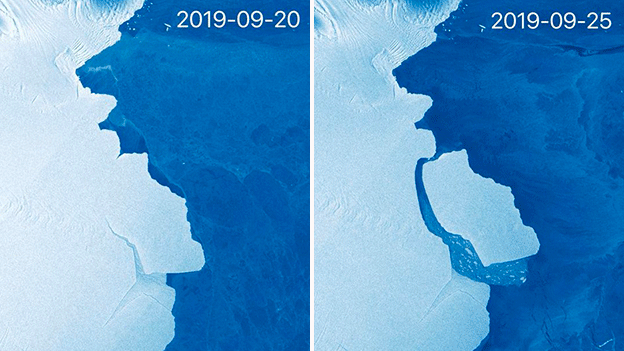
An incredibly massive iceberg has just been formed after a 1,636 square kilometer block of ice separated, or calved, from the Amery Ice Shelf in Antarctica. Dubbed D28 by scientists, it is the biggest iceberg to be formed by the Amery Ice Shelf since the early 1960s when an enormous 9,000 square meter iceberg broke free.
The name D28 is derived from the quadrant of Antarctica from which it originated. The D quadrant covers the longitudes 90 degrees East to zero degrees, the Prime Meridian.
Just to put the size of this floating block of ice into perspective, the greater London area, in England, is 1,500 square kilometers and Sydney, Australia's urban area is only slightly larger at 1,687 square kilometers. Therefore, D28—sitting somewhere inbetween—seems to be exceedingly large. The magnificent iceberg has also been estimated to have a thickness of at least 210 meters and is believed to contain roughly 315 billion tons of ice.
Seeing as how the Amery Ice Shelf is a key run-off for Antarctica, scientists have been anticipating a large scale calving for years now. However, their focus was placed in a different area. An area actually, slightly to the left of D28. A giant, seemingly loose section of the glacier appropriately called "Loose Tooth".
Professor Helen Fricker from the Scripps Institution of Oceanography predicted that Loose Tooth would separate sometime between 2010 and 2015. Loose Tooth, however, is still dangling from the ice shelf.
"I am excited to see this calving event after all these years. We knew it would happen eventually, but just to keep us all on our toes, it is not exactly where we expected it to be," she said.
Professor Fricker has maintained that the calving of D28 and the expected separation of Loose Tooth are not derived from climate change.
"While there is much to be concerned about in Antarctica, there is no cause for alarm yet for this particular ice shelf," Professor Fricker told the BBC.
Some moderate changes are expected as a result of the calving of D28. This could in fact prompt the separation of Loose Tooth as well as impact the cracking behavior of the ice shelf. The Australian Antarctic Division will be monitoring the activities closely, as they have the proper instrumentation already in the area.
Scientists expect D28 to float through the sea at a trajectory moving westerly carried by currents and pushed by winds. It is also expected to take a number of years before the iceberg breaks apart completely and eventually melts.
Prior to the calving of D28, Antarctica produced another massive iceberg. A68 broke loose from the Larsen C Ice Shelf back in 2017 and is nearly three times the size of D28.
© 2026 ScienceTimes.com All rights reserved. Do not reproduce without permission. The window to the world of Science Times.










